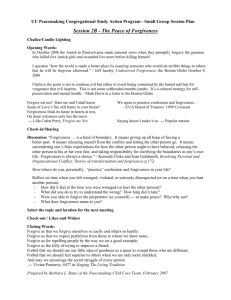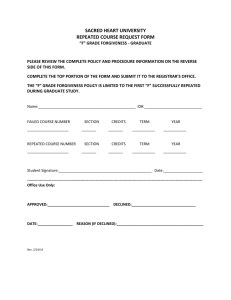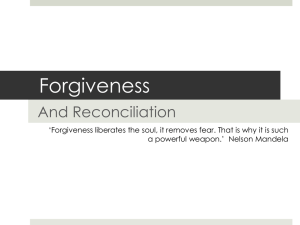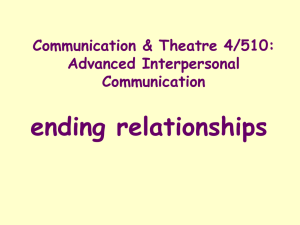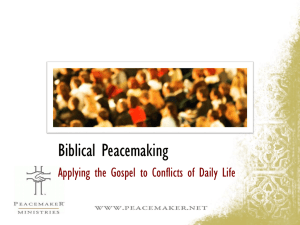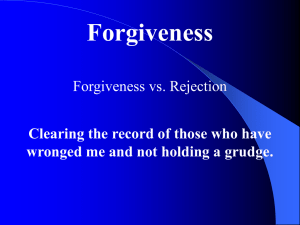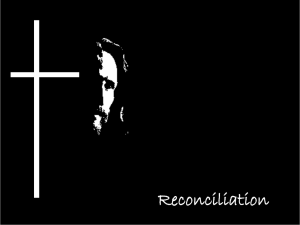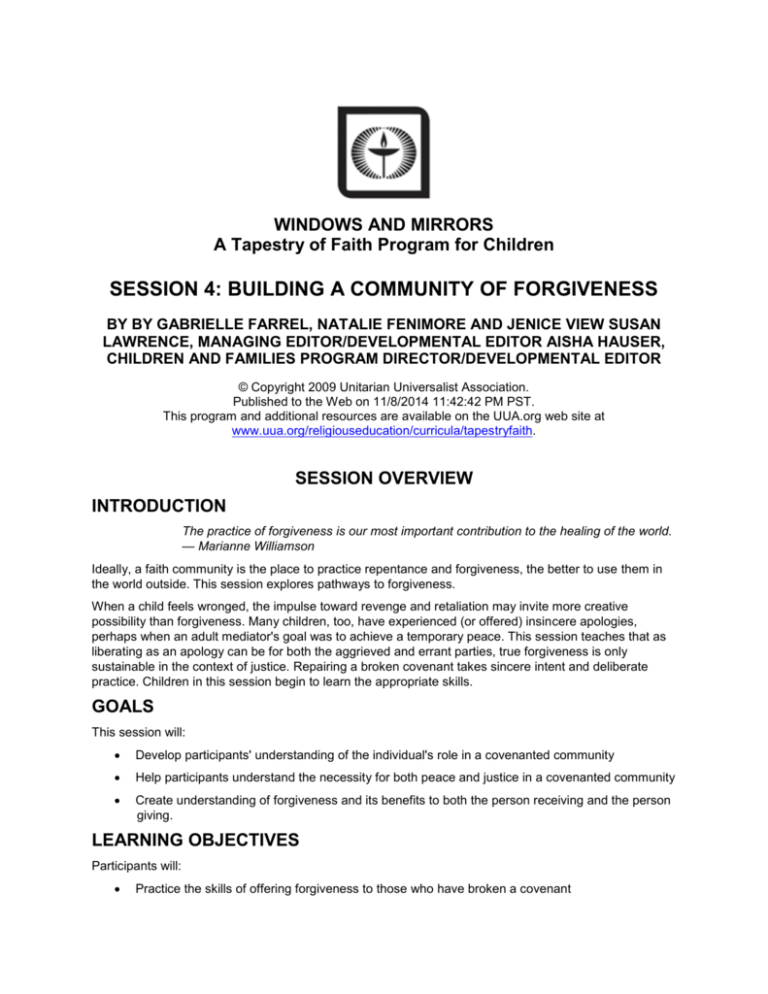
WINDOWS AND MIRRORS
A Tapestry of Faith Program for Children
SESSION 4: BUILDING A COMMUNITY OF FORGIVENESS
BY BY GABRIELLE FARREL, NATALIE FENIMORE AND JENICE VIEW SUSAN
LAWRENCE, MANAGING EDITOR/DEVELOPMENTAL EDITOR AISHA HAUSER,
CHILDREN AND FAMILIES PROGRAM DIRECTOR/DEVELOPMENTAL EDITOR
© Copyright 2009 Unitarian Universalist Association.
Published to the Web on 11/8/2014 11:42:42 PM PST.
This program and additional resources are available on the UUA.org web site at
www.uua.org/religiouseducation/curricula/tapestryfaith.
SESSION OVERVIEW
INTRODUCTION
The practice of forgiveness is our most important contribution to the healing of the world.
— Marianne Williamson
Ideally, a faith community is the place to practice repentance and forgiveness, the better to use them in
the world outside. This session explores pathways to forgiveness.
When a child feels wronged, the impulse toward revenge and retaliation may invite more creative
possibility than forgiveness. Many children, too, have experienced (or offered) insincere apologies,
perhaps when an adult mediator's goal was to achieve a temporary peace. This session teaches that as
liberating as an apology can be for both the aggrieved and errant parties, true forgiveness is only
sustainable in the context of justice. Repairing a broken covenant takes sincere intent and deliberate
practice. Children in this session begin to learn the appropriate skills.
GOALS
This session will:
Develop participants' understanding of the individual's role in a covenanted community
Help participants understand the necessity for both peace and justice in a covenanted community
Create understanding of forgiveness and its benefits to both the person receiving and the person
giving.
LEARNING OBJECTIVES
Participants will:
Practice the skills of offering forgiveness to those who have broken a covenant
Connect their own thoughts and experiences with a story about a group of Buddhist students'
experience of covenant and forgiveness
Articulate ways they express and consider ways to enforce the group covenant
Understand how practicing forgiveness helps heal hurt feelings
Commit to practicing at home forgiveness skills learned during the session.
SESSION-AT-A-GLANCE
Activity
Minutes
Opening
5
Activity 1: Law, Crime and Punishment
5
Activity 2: Game — Steal the Bacon
10
Activity 3: Story — Teaching a Thief
15
Activity 4: Write a Letter of Forgiveness
15
Activity 5: Window/Mirror Panel — Forgiveness Heart
5
Faith in Action: International Forgiveness Day
Closing
5
Alternate Activity 1: Spiritual Practice — Forgiveness Meditation 15
SPIRITUAL PREPARATION
Find a place where you can be quiet with your thoughts. Make yourself comfortable and light a candle to
mark the time as different from other activities. Close your eyes and breathe deeply for about five
minutes; perhaps repeat a word or phrase to separate you from the activities of the day. After opening
your eyes, consider:
When or to whom have you had a difficult time offering forgiveness?
How does this affect your life?
How do you perceive the children in the group feel or think about breaking the rules and seeking
forgiveness? How might they understand this session?
What models of forgiveness do children see among the adults in the congregation? Are these
useful models or negative models?
What are your expectations for this session? What do you hope is created at its conclusion?
What difference do you hope it makes?
SESSION PLAN
OPENING (5 MINUTES)
Materials for Activity
Chalice or LED/battery-operated candle
Large, round mirror to hold the chalice
Reflective materials, such as beads or pieces of stained glass
Newsprint, markers and tape
Opening Words Basket and opening words (see Session 1, Leader Resource 1 (at
www.uua.org/re/tapestry/children/windows/session1/sessionplan/leaderresources/143368.shtml))
Optional: A copy of the Unitarian Universalist hymnbook, Singing the Living Tradition
Optional: Bell , chime or other sound instrument
Preparation for Activity
Set up the chalice on the mirror to enhance its reflection. The chalice may be filled with reflective
materials, such as beads or pieces of stained glass, to represent the idea of light, reflection and
mirrors.
Write the words to "Spirit of Life," Hymn 123 in Singing the Living Tradition, or another hymn you
prefer, on newsprint, and post.
Obtain a basket to hold numerous slips of paper with opening words. Print Session 1, Leader
Resource 1, Opening Words for Basket, cut out the short readings and place them in the basket.
Of course, feel free to add your own.
Prepare to lead the group in singing "Spirit of Life," or another song commonly sung in your
congregation. Optional: Arrange to have someone else who is musical lead the singing, perhaps
with instrumental accompaniment.
Description of Activity
This ritual welcoming reminds participants of the relational nature of the group experience. Gather the
children in a circle around the chalice. Invite them to take a deep breath and release it, and create a deep
silence for a moment.
Ask a volunteer to take a reading from the Opening Words Basket and read it aloud. Invite another
volunteer to light the chalice. Then, lead a greeting:
Now we will take a moment to greet the people next to us. If you are next to someone
who is new to our group, offer a welcome, tell them your first and last name, and learn
their name.
Lead the group in singing the hymn you have chosen. Singing a congregational favorite helps children
grow in their sense of belonging in congregational life
If you choose not to sing, use a bell as a signal for the group to still themselves for another moment of
silence.
Ask the child who lit the chalice to extinguish it. Ask the child who read the opening words to return the
reading to the Opening Words Basket.
Including All Participants
If you have a non-sighted participant who reads braille, obtain the braille version of Singing the Living
Tradition from UUA Bookstore. The bookstore orders from an outside publisher, so order several weeks
ahead.
ACTIVITY 1: LAW, CRIME AND PUNISHMENT (5 MINUTES)
Materials for Activity
Newsprint, markers and tape
Preparation for Activity
On a large sheet of newsprint make three columns. Write the word "Crime" over the first column,
"Mild Punishment" over the second and "Harsh Punishment" over the third. In the "Crime"
column, write these examples of behavior that would be considered breaking either a covenant
or the law:
o
Stealing a pencil
o
Stealing your parents' car
o
Stealing a stranger's car
o
Robbing a bank
o
Stealing retirement money from elderly people
o
Stealing someone's land
Leave room to add others the children may contribute.
Description of Activity
Children begin thinking about the "gray areas" of rule-breaking. This activity helps prepare them to be
open to forgiveness.
Briefly discuss the concepts of law (rules we all agree to follow), crime (a harsh action that breaks the
rules) and punishment (a penalty or price for breaking the rules). Mention that in many religions, cultures
and legal systems, the penalty must fit the crime — for example, an eye for an eye, a tooth for a tooth
(Exodus 21:23-27); no cruel or unusual punishment (the 8th Amendment of the U.S. Constitution).
Ask the children what they believe should be the mildest and harshest punishment for each crime listed
on the newsprint. There may be some debate about appropriate punishment; you might suggest a quick
vote among the group. Write their responses on the newsprint. Let the children know they will have an
opportunity to revisit this list later in the session. Keep the list posted—or put it aside to use in Activity 4,
Write a Letter of Forgiveness.
ACTIVITY 2: GAME — STEAL THE BACON (10 MINUTES)
Materials for Activity
An object that serves as the "bacon" (something that will not roll or bounce; a glove or hat works
well)
Preparation for Activity
Create a space large enough for the group to form two lines facing each other and about 10—15
feet apart.
Agree about who will be the umpire. If there is an even number of children, an adult can be
umpire; if not, one of the children can be umpire.
Agree to play the game until one side earns 5 points.
Description of Activity
This game uses fast-paced movement to explore the penalty for getting caught "stealing the bacon." The
object of Steal the Bacon is to take the "bacon" back to your own side without being caught.
Form the children into two teams. Ask each team to count off, starting with the number 1. The two teams
face one another in a straight line approximately 10—15 feet apart.
The umpire calls out a number. The players on each side who are assigned that number are the players
for that round. No other team members may leave their side of the field.
Neither player may touch the other until someone touches the bacon. Once a player touches the bacon,
however, the other player may tag him or her.
If a player is able to grab the bacon and carry it back over to their own side, that team scores a point. If a
player is tagged after touching the bacon but before returning to their own side, the team that tagged him
or her scores a point.
What usually happens is that both kids run out and then hover over the bacon, each waiting for a slight
advantage to grab it and run back before the other can react.
The game is over when a predetermined number of points are scored or when all numbers have been
called.
Including All Participants
Be mindful of accessibility issues. Participants with those issues may serve as umpire, or the game can
be modified. Instead of running in and out of line, have the players whose turn it is sit or stand next to
one another with the “bacon” in the center; the first person to snatch it gets the point.
ACTIVITY 3: STORY — TEACHING A THIEF (15 MINUTES)
Materials for Activity
A copy of the story "Teaching a Thief (included in this document) "
A bell, chime, rain stick, or other musical noisemaker
Preparation for Activity
Consider telling the story rather than reading it from the page or read it dramatically.
Practice telling it or reading aloud. Try adopting different voices for different characters.
Description of Activity
Read or tell the story. Carefully review the questions and choose those that you think might resonate with
your group. These questions are meant to help these particular children interpret the story and relate it to
their own lives.
Explain that now we are going to practice listening and discussing skills. As we find out what one another
thought about the story, both skills are needed to understand the story better from the multiple
perspectives in the room.
Encourage children to pay attention to what they found meaningful in the story. Begin by asking the
children to retell the story in their own words, briefly. What children recall and relay tells you what they
consider most meaningful or memorable.
What happened in this story?
Have you ever been like the other students—angry when it seemed that someone got away with
breaking the rules?
Refer to the list of punishments the children created in Activity 2; what kind of punishment do they
think the thief should have received?
Have you ever been like the thief—breaking a rule of your family or group?
How were you treated when your "crime" was discovered?
Does that ever happen in this room?
When should people be forgiven and why?
Are there acts that are unforgivable?
Are there people who are unforgivable?
What would happen if you forgave them?
In our congregational community, do we have a special obligation to forgive one another?
You may wish to pose to the group a mirror and a window question:
Mirror: How do I apologize for breaking a rule of the group?
Window: Who do we forgive? Why?
Conclude by briefly sharing what this story teaches you about forgiveness and how it can help you and
others remake the world. You can say:
Our Unitarian Universalist faith calls us to affirm the inherent worth and dignity of every
person. One way to do this is through the practice of forgiveness when someone has
hurt us.
Thank everyone for their observations and sharing.
ACTIVITY 4: WRITE A LETTER OF FORGIVENESS (15 MINUTES)
Materials for Activity
Leader Resource 1, Three-Step Forgiveness Letter (included in this document)
Paper and pencils for all participants
Newsprint sheets generated in Activity 1, Law, Crime and Punishment
Optional: Newsprint, markers and tape
Preparation for Activity
Decide how you will lead the participants to write Forgiveness Letters. You may want to do any or
all of these:
o
Read aloud the directions and examples for each of the three steps outlined in Leader
Resource 1.
o
Provide copies of the leader resource to all participants.
o
Write the directions and examples on newsprint and post.
Print Leader Resource 1. Make the copies you will need, and/or write directions and examples on
sheets of newsprint, and post.
If you have taken it down, post the newsprint with punishments for particular offenses the group
listed in Activity 1.
Think of a few examples of breaking a group covenant, to prompt the children's ideas.
Description of Activity
Children practice forgiving others in a way that validates their own feelings of hurt and betrayal while
preserving the dignity of the person who has broken their covenant.
Direct children's attention to the three steps of the Forgiveness Letter posted on newsprint and/or copies
of the leader resource. Go through the directions. Explain that it is very important to go through all three
steps. Say, in your own words:
If you only write the feeling letter without coming to forgiveness, you will just be stuck in
your anger. If you just write the forgiveness letter without writing the feeling letter and the
response letter, it may feel fake.
Then, invite children to think about a time when someone hurt them by breaking a rule or committing a
wrong. The rule might be a written rule, but it may also be an unspoken rule, such as a covenant
between friends about how they will treat one another, or a covenant between parent and child about
what is fair.
While children are thinking, hand out blank paper. Then, ask each child to write a Feeling Letter. Say:
Write your feelings to the person that upset you. Imagine that they are listening with love
and compassion, the way you would have liked them to listen in the first place.
Read aloud the Feeling Letter example from the leader resource. Challenge children to express their
feelings briefly, in two or three sentences. Tell them, "When you write a Feeling Letter, it is usually best
not to send it. It is just to clear your mind of the anger and resentment."
Give the group several minutes to write. Next, tell the children they will write a Response Letter. Say:
This is a letter from the person to whom you have written the Feeling Letter. This letter is
not to be sent, either. Write what you wish and imagine the person would respond to
your Feeling Letter, now that they know your feelings. Do not have them only apologize.
Have them write that they will take some action — an action that would make you feel
better. An action that shows they are truly sorry and are looking for a solution.
Point out the sheet of newsprint which lists the punishments the group generated earlier in Activity 1.
Suggest the list may give children some ideas for what they wish the person would do as part of their
apology. Read the Response Letter example from the leader resource. Give the children a few minutes
to write their Response Letters on the same sheet of paper.
Then say:
The final step of writing a Forgiveness Letter is another letter from you to them. This
letter will be just a few short sentences that express your forgiveness and love. If you
cannot forgive them yet, tell them you want to forgive them.
Distribute new sheets of paper. Read aloud the Forgiveness Letter example and give the children a few
minutes to write.
When children are finished writing, ask how they think the process they have just gone through and/or
giving the actual Forgiveness Letter to the person might help them forgive the person who has hurt them.
Ask:
Does a punishment need to be part of the solution?
Can we forgive without apologies or punishments? Why, or why not?
Remind the children that this is just practice for when they want to write a real Forgiveness Letter to
someone, though if they like, they can give the Forgiveness Letter to the person they wrote it to. Then
say:
While the Feeling Letter and the Response Letter are not intended to be shared, the
things you wrote in those letters may have helped you know what you want to say to the
person who hurt you, and what you wish they might say back.
Suggest children rip up their Feeling and Response letters or place them in a private place, such as their
personal diaries or journals.
Make sure the children have decided what to do with their three letters before moving on to the next
activity.
Including All Participants
If any participants may struggle with this level of writing assignment, offer all the children the options of
drawing the three steps as pictures or dictating their letters to an adult. Make sure you have drawing
materials as well as writing materials, and a space where a child can tell an adult what to write in privacy.
ACTIVITY 5: WINDOW/MIRROR PANEL — FORGIVENESS HEART (5
MINUTES)
Materials for Activity
All participants' Window/Mirror Panels
Color pencils (sharpened or with a sharpener available)
Basket(s) of window/mirror panel materials:
o
Sheets of Mylar(R) in several colors, shiny gift wrap, aluminum foil and other reflective
paper
o
Sheets of plain or construction paper
o
Scraps of fabric
o
Color markers (permanent markers work best on Mylar)
o
Glue sticks, tape (including double-sided tape) and scissors (including left-hand scissors)
o
Optional: Stick-on sequins, a hole-puncher, yarn, ribbon and a variety of magazines to
cut up
Preparation for Activity
Cut out heart shapes from paper or Mylar. Hearts should be five inches at the widest point (or
larger, if children's Window/Mirror Panels are quite large). You may wish to make a variety of
colors or sizes to offer children some choices. If you use Mylar, children will need permanent
markers to write on their hearts.
Have materials, including children's Window/Mirror Panels, easily accessible.
Make sure pencils are sharpened.
Description of Activity
Invite children to get their Window/Mirror Panels and settle at work tables. Distribute Window/Mirror
Panel baskets of materials. Give each participant a heart shape.
Invite participants to decorate their heart in response to the question "What does forgiveness mean to
you?" Tell them they may write or draw their idea of forgiveness and then add their forgiveness heart to
their Window/Mirror Panel. If they are writing, ask them to begin with "Forgiveness is... ."
Keep instructions to a minimum. Explain that they have a very short time to complete this and discourage
them from over-thinking it. Let each participant choose where the piece should go on their panel and help
them attach it.
Including All Participants
A participant who cannot write or draw may be able to dictate their thoughts to a co-leader to write on a
heart. You might invite the participant to choose another child who has finished their own heart to
decorate theirs, too, according to their instructions.
CLOSING (5 MINUTES)
Materials for Activity
Newsprint, markers and tape
Taking It Home handout
Optional: A copy of Session 1, Leader Resource 2, Namaste (at
www.uua.org/re/tapestry/children/windows/session1/sessionplan/leaderresources/143369.shtml)
Preparation for Activity
Identify a place for participants to store their Window/Mirror Panels between sessions. Keep in
mind, there may be times the panels are not entirely dry when the session ends.
Write the closing words on newsprint and post.
Download and adapt the Taking It Home section and copy as a handout for all participants (or,
email to parents).
Optional: Review the leader resource so you can briefly explain the origin and meaning of
"namaste" and demonstrate the accompanying gesture.
Description of Activity
Explain that the session is almost over and we will now work together as a community to clean the
meeting space. Ask everyone first to clean up their own area and the materials they were using, then
clean another area or help someone else. No one should sit in the circle until the meeting space is clean.
Then bring the group back to the circle. Ask them to think about what happened today that was good or
what they wish had gone better. If you are running short of time you can ask them for a "thumbs up" or
"thumbs down" on the session.
Invite each participant to say, in a word or sentence, why it is important for them to be a part of this faith
community. You may go around the circle for responses; allow individuals to speak or pass.
Then ask everyone to hold hands and say together:
Keep alert;
Stand firm in your faith;
Be courageous and strong;
Let all that you do be done in love. — 1 Corinthians 16
If this is the first time the group is using "namaste," briefly explain its origin and meaning. Then, lead the
group in the word and bowing gesture. Or, substitute "thank you." Invite each participant to bow their
head to the individuals on either side and then bow to the center of the circle and say "thank you"
together.
Distribute the Taking It Home handout you have prepared. Thank and dismiss participants.
FAITH IN ACTION: INTERNATIONAL FORGIVENESS DAY
Materials for Activity
Newsprint, markers and tape
Blank paper and pencils, crayons or markers for all participants
Optional: From the International Forgiveness Day (at www.forgivenessalliance.org/day.html)
website, handouts describing the organization's activities
Preparation for Activity
Optional: Prepare a few handouts that describe International Forgiveness Day activities.
Read the Truth and Reconciliation Report for the Children of Sierra Leone (at
www.trcsierraleone.org/pdf/kids.pdf) to learn how an entire society has worked to develop a
justice and healing process that includes children. Even though it is written for children, the 62page report is probably too dense and graphic to share in the session. Glean ideas you can
apply to your leadership of this group, perhaps as a model for how your community or
congregation could collectively nurture forgiveness.
Description of Activity
Explain that International Forgiveness Day, variously held on August 1 or the first Sunday of August, is a
time when groups of people gather to ask and grant forgiveness. We do not need to wait until August to
create a forgiveness event for our congregational community. Form small groups of at least four children,
each with an adult facilitator if possible. Ask the children to brainstorm ideas for how the entire
congregation could participate in a Forgiveness Day.
Give the small groups a few minutes to generate ideas. Then ask them to share in the larger group. Write
down all the ideas. If no one has suggested it, propose that the day include a ceremony of writing
Forgiveness Letters. Lead a discussion to shape a concrete proposal.
Now ask children to think about all the people they would need to help them organize a Forgiveness Day
and write the names on the large sheet of paper. Decide when you might want to hold a Forgiveness Day
with the larger church community. Make a commitment to propose Forgiveness Day to your religious
educator and minister.
LEADER REFLECTION AND PLANNING
Reflect on and discuss with your co-leader(s):
How did the timing go today? What might we do to make it work better?
What worked well? What didn't?
What connections did children make with the activities and/or the central ideas? How could you
tell that was occurring?
What connections did you make with the children? What connections did the children make with
each other? How was this evident? How could a sense of community be improved with this
group?
Approach your director of religious education for guidance, as needed.
TAKING IT HOME
The practice of forgiveness is our most important contribution to the healing of the world.
— Marianne Williamson
IN TODAY'S SESSION...
We affirmed the value of forgiving people who break the rules of a community. We explored the idea of
expressing righteous anger when we have been hurt by someone, seeking that person's sincere apology,
and then letting go of the anger by offering sincere forgiveness. The practices we used in this session
can be used in daily life.
EXPLORE THE TOPIC TOGETHER. Talk about...
Ask your child what they found most meaningful about their religious education session today—having
this conversation directly afterward tends to yield the most information. You might ask, "What do you
think about forgiveness?" Ask them whether and how they have been hurt by someone whose apology
they seek. Ask them what it would take for them to forgive that person. Ask them what practices they
learned today that might help them. Share about a time you have sought forgiveness when you knew you
had hurt or wronged someone. Share about at time you forgave someone else. Be honest about how
forgiving and seeking forgiveness have been challenging or rewarding for you.
EXTEND THE TOPIC TOGETHER. Try...
Have each member of the family write a forgiveness letter to someone else. Invite everyone to prepare
by writing their feelings of hurt or betrayal first, then writing an imaginary apology from the person who
hurt them. These writings should stay private; it may be a good idea to rip them up.
Then, each person writes a sincere letter of forgiveness, or a letter that says they want to forgive the
person (but are not yet ready). If there are young members of the family who haven't learned to write yet,
ask them to talk about forgiving someone who hurt their feelings. Share the forgiveness letters with each
other. Affirm that forgiveness is important for a healthy family.
FAMILY DISCOVERY
Find out online what a group called the Worldwide Forgiveness Alliance (at
www.forgivenessalliance.org/day.html) does to promote forgiveness, including a day in August for local
celebrations of forgiveness and a web page of " forgiveness heroes (at
www.forgivenessalliance.org/heroes.html)."
ALTERNATE ACTIVITY 1: SPIRITUAL PRACTICE — FORGIVENESS
MEDITATION (15 MINUTES)
Materials for Activity
A chime or a bell
Leader Resource 2, Forgiveness Meditation for Children (included in this document)
Preparation for Activity
Review Leader Resource 2, Forgiveness Meditation for Children, and prepare to lead the
meditation. You can learn more from a website about Buddhism (at
buddhism.kalachakranet.org/Meditations/love_forgiveness_meditation.html) that explores love
and forgiveness meditations.
Make sure to use an area large enough to accommodate all the group participants lying on the
floor or sitting comfortably in chairs. If necessary, consider multiple separate areas to hold the
activity.
Description of Activity
This activity offers a spiritual practice that children can use throughout their lives. It is a Buddhist practice
of forgiving oneself, asking forgiveness from people whom we have harmed, and forgiving people whom
we love as well as people we do not yet love.
Ask the children what they know about meditation. Allow some responses. Then, invite them to lie
comfortably on the floor or to sit in their chairs. Lead them in taking three deep breaths. Ask children to
repeat silently to themselves each phrase you will read aloud.
Using Leader Resource 2, read the Forgiveness Meditation aloud, leaving time between phrases or
sentences for the children to repeat the words to themselves.
Ring the chime or bell to end the meditation. Then invite the children to remain silent for 15 seconds. To
finish, stretch arms overhead and then bring arms down to sides.
Thank them for their participation.
Including All Participants
Be mindful of accessibility issues. Invite participants to stretch as they are willing and able.
WINDOWS AND MIRRORS: SESSION 4:
STORY: TEACHING A THIEF
"Teaching a Thief" is taken from Kindness, A Treasury of Buddhist Wisdom by Sarah Conover and
Valerie Wahl (Boston: Skinner House, 2010). Availavle from the UUA Bookstore. All rights reserved.
Bankei was a famous Zen teacher in Japan long ago. Students from all over came to his monastery for
months of study and meditation. To make it through such intensive training is not an easy thing: There is
much hard work to be done, many hours of meditation, little sleep, and only small, spare meals.
Once during the time at the monastery, a student found that all he could meditate on was his empty
stomach. It was also all that he thought about during work and all he thought of even when eating!
Finally, he could not stand it a day longer. In the night, ever so quietly, he sneaked into the kitchen,
hoping to make off with something tasty and filling. But the head cook—always alert even when asleep—
awoke and caught him.
The next morning, the matter was brought to Bankei in hopes that the student would be forced to leave.
However much to the group's dismay, Bankei thanked them for the information and acted as if nothing
had happened.
Just a few days later, the same pupil was caught stealing food from the kitchen again. The students were
even angrier. It was in the middle of the night when the thief was apprehended, but they wrote a petition
right there and then to their teacher Bankei. They each vowed to leave the monastery the next day if the
thief was not expelled.
When Bankei read the petition the next morning, he sighed. He went outside to the monastery gardens
and paced thoughtfully. At last he asked that all the monks and students—including the thief—be brought
together. They gathered in the temple hall, becoming quiet when Bankei entered.
"Many of you have come from far away to be here," announced Bankei. "Your hard work and
perseverance are to be praised. You are excellent, dedicated students. You have also clearly
demonstrated that you know wrong from right. If you wish, you may leave this monastery and find
another teacher. But I must tell you that the thief will remain, even as my only student."
The students were appalled! A murmur of discontent hummed about the room. How could their teacher
ask them to leave?
Who had done the wrong thing? Only the thief! Feeling anger of the other students, the thief in their midst
hung his head in disgrace.
"My friends," Bankei gently continued, "this thief does not understand the difference between right and
wrong as you do. If he leaves, how will these things be learned? He needs to stay here so he can also
understand."
When the thief heard these words, he felt profoundly moved. Tears sprung to his eyes. But even through
his shame in front of the others, he felt Bankei's deep compassion. He knew he would not steal anymore.
Bankei ended his speech. He left the hall, leaving the students to make their individual decisions. The
thief immediately took a spot on a meditation bench and set about meditating. Many of the students
stood right up to leave the monastery. Somewhat confused by Bankei's speech, they discussed things
among themselves. All except for the presence of one student—the thief—the great hall emptied for a
time.
When Bankei returned an hour later, it was so quiet he assumed all the students had left, just as they
had vowed. But much to his surprise, every last student had returned. All were quietly sitting, composed
in meditation. The wise and kind Bankei smiled at such a wonderful sight.
WINDOWS AND MIRRORS: SESSION 4:
LEADER RESOURCE 1: THREE-STEP FORGIVENESS LETTER
Step One: Feeling Letter
Dear (person's name),
A) Anger. Write your feelings of anger. I am angry that... / I am furious... / I hate...
B) Sadness. Write your feelings of sadness. I am sad that...
C) Fear. Write your feelings of fear. I am afraid that...
D) Sorrow or regret. Write your feelings of lament. I am sorry that...
Signed, (your name)
EXAMPLE
Dear Pogo,
I am angry that you stole my pencil and tried to pretend the dog took it. It makes me feel like you don't
respect me or my things. I thought you were my friend but you don't act like a friend. That makes me sad.
I don't want to talk to you anymore.
Signed, Logo
Step Two: Response Letter
Dear (your name),
(Write their letter to you)
Signed, (person's name)
EXAMPLE
Dear Logo,
I am sorry I stole your pencil and I am sorry I lied and said it was the dog who took it. I really want you to
be my friend, but I guess I need to act like a friend first. Please forgive me. I will do (insert solution) to
make it up to you.
Signed, Pogo
Step Three: Forgiveness Letter
Dear (person's name),
(Write your letter)
Signed: (your name)
EXAMPLE
Dear Pogo,
I forgive you for taking my pencil and lying about it. Of course I want to be your friend. Let's agree to
respect each other's things and tell the truth.
Signed, Logo
WINDOWS AND MIRRORS: SESSION 4:
LEADER RESOURCE 2: FORGIVENESS MEDITATION FOR CHILDREN
From the website A View on Buddhism .
Give children a moment each time you ask them to picture someone new.
Read aloud the words you want children to say silently to themselves one phrase at a time, with pauses
in between.
Picture yourself in your mind. As you breathe in and out, repeat these words silently to yourself:
I forgive myself for whatever I did, on purpose or by accident.
May I be happy, free of confusion, understand myself and the world.
May I help others to be happy, free of confusion, and full of understanding.
Now picture in your mind a person you love and want to forgive.
As you breathe in and out, repeat these words silently to yourself:
From my heart, I forgive you for whatever you did, on purpose or by accident.
May you be happy, free of confusion, and understand yourself and the world.
Please forgive me for whatever I did to you, on purpose or by accident.
May we open our hearts and minds to meet in love and understanding.
Try to feel the warmth of the healing between you.
Now picture in your mind someone you have hurt.
As you breathe in and out, repeat these words silently to yourself:
Please forgive me for whatever I did to you, on purpose or by accident.
May you be happy, free of confusion, and understand yourself and the world.
Please forgive me for whatever I did to you, on purpose or by accident.
May we open our hearts and minds to meet in love and understanding.
Try to feel the warmth of the healing between you.
Now picture in your mind a person you do not like very much.
As you breathe in and out, repeat these words silently to yourself:
Please forgive me for whatever I did to you, on purpose or by accident.
May you be happy, free of confusion, and understand yourself and the world.
Please forgive me for whatever I did to you, on purpose or by accident.
May we open our hearts and minds to meet in love and understanding.
Try to feel the warmth of the healing between you.
FIND OUT MORE
Ideas about Forgiveness
You can explore:
Buddhist ideas about forgiveness at The Forgiveness Meditation (at
buddhism.kalachakranet.org/Meditations/love_forgiveness_meditation.html)
Atonement for breaking a covenant at Judaism 101—Yom Kippur Day of Atonement (at
www.jewfaq.org/holiday4.htm).
A variety of perspectives at Why Forgive? (at explorefaith.org/forgive/index.html)
A 2004 essay by Episcopal priest L. William Countryman, "Forgiveness and Justice," (at
www.explorefaith.org/forgive/countryman.html) challenges the idea of retribution as justice and presents
an alternate view. The essay reads, in part:
Justice seeks the world of "shalom," the life of the age to come. It will do nothing that
would make such a world impossible. It will do anything that might actually bring it closer.
It will even forgive. Instead of dedicating ourselves, then, to the impossible task of getting
the past right, we find ourselves freed by forgiveness to live fully in the present and to
begin building something new and better.

